Top News
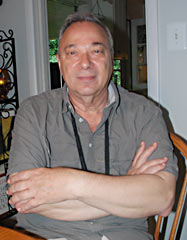
May 28, 2012 Hideki Matsudo of Ryukyu Shimpo reports from Washington D.C.
On May 27, former chief analyst Arthur Rex Rivolo, who testified before the House of Representatives in June 2009 on the inability of the MV-22 Osprey vertical take-off and landing transport aircraft to safely autorotate, responded to a request from the Ryukyu Shimpo for an interview. With regard to the planned deployment to U.S. Marine Corps Air Station Futenma, the former chief analyst said, “In a combat operation it is very dangerous. However, the chances of an engine failing in peacetime are very rare. In peacetime, the Osprey, I think, is very safe.” However, he said, ” If the engines stop in the MV-22 over a city, that will be a problem, it will crash . . . uncontrolled crash wherever it happens to be.” Rivolo added, “The airplane won’t do an autorotation, so basically it’s a very serious hole in the safety of the airplane.”
Autorotation is the state of flight in which the main rotor system of a helicopter is turned by the action of air moving up through the rotor rather than engine power driving it. A helicopter can be landed safely in the event of complete engine failure. Rivolo pointed out that for the Osprey, “The simulator training does not do the autorotation correctly.” He stated, “The MV-22 would fail to meet basic air worthiness directives of the FAA if it were a civilian transport. Although the airworthiness requirements of the FAA do not apply to military aircraft, equivalent requirements have been imposed on all passenger-carrying military aircraft in the past. The MV-22 represents the first departure from this policy within the Defense Department.”

MV-22 Osprey vertical take-off and landing transport aircraft
With regard to its deployment to Futenma Air Station, he commented that an accident is unlikely because the pilot will not be required to undertake high-level maneuvering as long as the aircraft is being operated from an airfield because it is not necessary to avoid a possible enemy attack in the combat zone, and also that the airplanes will be very well serviced on a base, which is different from in a battlefield situation or on a warship.
At the same time, he touched upon the chances of an engine failing in flight, saying, “We have the possibility of an airplane crash because of bad fuel that’s got water or contaminants, so it stops the engines. The two engines are tied together with a drive shaft. That drive shaft is made out of composite. If there is a fire in there, the airplane will crash.” He stated that every five years or so they have a helicopter crash caused because of bad fuel. The U.S. Marines stated that it would be almost impossible for the MV-22 engines to stop. Rivolo commented, “It will crash . . . uncontrolled crash if its engines stop working when it’s in helicopter-mode.” He said that some young people will be killed in combat operations in these crashes. The former chief analyst confirmed previous statements in the House in his interview with the Ryukyu Shimpo, saying, “It is a disregard for soldiers’ lives. Yes, and I still believe it.”
(English translation by T&CT, Mark Ealey)
Go to Japanese

May 27, 2012 Ryukyu Shimpo
The 6th Pacific Islands Leaders Meeting (PALM6), which was held at the Bankoku Shinryokan resort in Nago, came to a close on May 26. Leaders from 16 Pacific island countries who participated in PALM6 released a joint document named the Okinawa Kizuna Declaration, which centers on five themes such as expanding cooperation in dealing with natural disasters and maintaining maritime order in the Pacific.
At the press conference, Prime Minister Yoshihiko Noda, who co-chaired the summit, said, “The Japanese government intends to provide up to 500 million dollars in aid over the next three years to support the sustainable development of Pacific islands including disaster cooperation.” Cook Islands Prime Minister Henry Puna said, “The spirit of kizuna (bonds) dominated our discussions throughout and because of that we could reach consensus and agreements.” Noda also stated that the Japanese government intends to cooperate in reducing disaster risks by setting up an early warning system capable of predicting the arrival time of tsunamis caused by earthquakes.
The spouses of the leaders visited elementary and secondary schools in Onna and spoke with students involved in activities to help protect coral reefs.
The Japanese and Pacific island leaders agreed to cooperate under the declaration, focusing on the five themes of (1) response to natural disasters (2) environment and climate change (3) sustainable development based upon human security (4) people-to-people exchanges and (5) maritime issues. The Japanese government announced that it will provide aid to the tune of 500 million dollars over the next three years to the other participant countries. Noda announced the “Kizuna Project,” through which 300 young people from Pacific islands countries will be invited to Japan this year to promote their understanding on its recovery from the Great East Japan Earthquake last year.
In the context of China’s growing influence in Pacific islands rich in fishing and other natural resources, Japan and the United States, which was invited to the summit for the first time, added maritime security to the agenda and confirmed the need to maintain maritime order in the Pacific.
During the press conference, Noda said, “Okinawa is similar to Pacific islands in terms of geography and climate. Okinawa and those islands also have the same problems since their remote islands have difficulty in securing water and energy. It was very meaningful to hold the summit in Okinawa in terms of cooperation in working on similar problems.”
(English translation by T&CT, Mark Ealey)
Go to Japanese

Go To Video

May 27, 2012 Ryukyu Shimpo
A dug-out shelter that would seem to have been built by the Imperial Japanese
Army (IJA) has been found in the hills of the Kenken district of Motobu. It is about 30 meters long, up to about two meters high and is one meter wide, and is probably one of the largest shelters surviving intact in the northern region of Okinawa. Tetsuo Tomori of the Motobu Municipal Museum said, “It is rare to find a shelter so large and well-preserved. We would like to consider using it for peace education.”
Local residents came across the shelter at the end of April, when work was restarted on upgrading a walking track that had been left unattended to for 21 years. There were no human remains inside the shelter, so Tomori surmised that, “The Imperial Japanese Army may have actually abandoned the location before it could be used in battle.”

According to a 10 August 1944 entry in the staff diary of the No. 3 Battalion of 15th Independent Mixed Regiment, a platoon of heavy artillery was deployed near Tobaru, which is close to Kenken, in order to provide fire-support to the forces on the island of Ie-jima. The shelter seems to be in this location. It was seen as critical for IJA units in the northern part of Okinawa to help protect Ie-jima, where important airfields were located.
Seventy-four year-old resident of Kenken Tatsuhiko Shiroma remembers seeing dozens of Korean laborers led by armed Japanese soldiers up towards the hills on a daily basis in the summer of 1944. He said, “I imagine that it was those Koreans who built the shelter.”
According to Shiroma, there was no fighting between the Imperial Japanese Army and the U.S. forces in the area because IJA troops retreated from Kenken after the massive air raid on Japanese installations in Okinawa on 10 October 1944. Shiroma said, “The Imperial Japanese Army suffered losses during that air raid, and may have changed their strategy, withdrawing from that location.”
(English translation by T&CT, Mark Ealey)
Go to Japanese
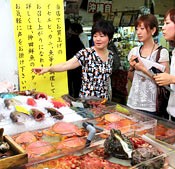
May 27, 2012 Takumi Takimoto of Ryukyu Shimpo
Yonner Food, a cooking school in Naha, has set up a cooking experience course as a new type of tour in which participants buy the required ingredients at the Makishi Public Market in Naha and then make Ryukyuan cuisine at the cooking school. The tour is designed so tourists can experience the Okinawan way of life through Ryukyuan cuisine and culture, and the initial response from travel companies is favorable. It will be included as a formal course in time for this summer season.
The school offers three courses: court cuisine, home-style meals and confectioneries. Before the cooking practical experience, participants purchase the required ingredients at the market, fish merchants, vegetable stores and butchers who are familiar to Kazumi Kayo, the head of the school. Talking with local merchants is also an enjoyable experience for the tourists.
In the cooking class, participants from outside of Okinawa asked Kayo about the names and the nutritional effects of Okinawan vegetables. The cooking experience course commenced with Kayo taking the participants on a tour of the market. They were pleased that they could enjoy the market in a slightly different way from when they visited it by themselves.
The course is between three and a half to four hours long, including about 30 minutes of shopping at the market, one hour and a half to two hours cooking, and 30 to 40 minutes of food tasting time. The course for home-style cooking is offered in groups of six people, with the tuition fee being 6000 yen per person, including ingredients, insurance and transportation. The Okinawa Industry Promotion Public Corporation is supporting the tour in the expectation that it has potential as a prefectural sightseeing offering.
Kayo said, “Tourists enjoy talking with local people in the market. They also buy local vegetables as souvenirs when they leave Okinawa.” A fitting of Ryukyu Dynasty traditional costume will be offered as an optional extra. She also plans to open an outside cooking class in the vicinity of the market. For further details call Yonner Food at 098-832-7747.
(English translation by T&CT, Lima Tokumori and Mark Ealey)
Go to Japanese
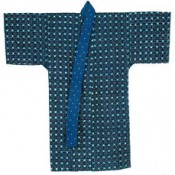
May 22, 2012 Ryota Shimabukuro of Ryukyu Shimpo
On May 21, the Ministry of Economy, Trade and Industry (METI) officially added Chibana hanaori from Okinawa City to the list of METI-designated traditional crafts. The ministry will make its final decision and the public announcement in July. After Yaeyama minsa and Yaeyama jofu in 1989, METI newly designated a traditional craft from Okinawa for the first time in 23 years, and with this Chibana hanaori becomes the 14th item. After the official designation, the government will support the opening up of new markets and the development of new products for Chibana hanaori based on a five-year development plan put together by the Chibana Hanaori Business Cooperative.
There are currently 212 traditional craft items designated by METI across the country. Following the 17 items from Kyoto and the 16 items from Niigata, Okinawa has the third most designated crafts in the country with 14 items.

partial enlargement
The unique characteristic of Chibana hanaori is the combination of tate-uki hanaori and nui-tori hanaori techniques. The designs of tate-uki hanaori are embossed vertically in series, whereas the threading is embossed like embroidery in the designs of nui-tori hanaori. The oldest Chibana hanaori in existence is thought to have been woven in the late 19th century.
Chibana hanaori was used for costumes worn at the traditional event of prayers for prosperity and a good harvest, called usu-deku. In addition to traditional kimono and obi, in recent years hanaori has been used for making neckties and bags.
Research about textiles in Okinawa was conducted in the 1930s mainly on the western side of the area around what is currently Route 58, but the eastern side of the island such as the area that was formerly Misato Village (now Okinawa City) where Chibana hanaori has been woven, was not researched in any great detail. Since the 1990s, professor at the University of the Ryukyus, Jun Kataoka, and his student Shin Koki started researching the technique, and collectors of old clothes are also helping with the research.
Okinawa City began promoting Chibana hanaori-related business in 2000 and the Chibana Hanaori Business Cooperative was formed in 2008. In 2010 March, the Okinawa Prefectural Government designated Chibana hanaori as a traditional craft.
(English translation by T&CT, Megumi Chibana and Mark Ealey)
Go to Japanese
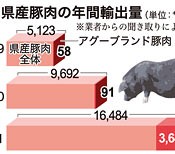
May 22, 2012 Maki Nagamine of Ryukyu Shimpo
Exports of Okinawan pork are increasing. According to the Livestock Division of the Agriculture, Forestry and Fisheries Department of the Okinawa Prefectural Government (OPG), the annual amount of exports of Okinawan pork has increased threefold in the three years from fiscal 2009 to 2011. The amount of the agu variety of pork, a traditional breed of Ryukyuan pig, has increased about 63 times. The OPG ascertained that the sales strategy aimed at rich foreigners was successful. For the future, using lump-sum subsidies for Okinawa development, they plan to strengthen the brand power and promote sales of Okinawan meat both domestically and abroad.
The OPG conducted a project to promote international sales of Okinawan meat in 2010. It encouraged job creation for meat distributors, and developed overseas markets. As a result, the annual amount of exports of Okinawan pork in 2009, at 5123 kilograms (11294.1 pounds), went up to 16484 kilograms (36340.4 pounds) in 2011. The amount of the agu variety of pork exported surged from 58 kilograms (127.9 pounds) in 2009 to 3642 kilograms (8029.1 pounds) in 2011.
As a part of the project, Maruichi-meat established an overseas division in 2010, and has promoted international sales to wealthy customers. The export volume of pork in fiscal 2009 of about two tons grew to about 15 tons in fiscal 2011. The company is exporting their original brands of pork of Aged Agu Pork, Kariyushi Aged Pork, and Masan Pork. They aim to increase sales from about 13 million yen in fiscal 2011 to 200 million yen in fiscal 2017. The president of the company, Zenei Yogi, said, “From now on, it is going to be very important to sustain the brand name. If we let the brand image slip, it will undermine the government’s efforts. I hope that the OPG registers a trademark and facilitates brand traceability.”
The OPG allocated 116.7 million yen to promote the domestic and international sales of Okinawan brand meat in fiscal 2012 including projects using the lump-sum subsidy. It plans to register a trademark of the family brand the Agu and to run a storage facility for Okinawan meat as a logistics base in Hong Kong, which is the main hub for exports.
Katsuya Namihira , the chief of the Livestock Division, said, “Wealthy people in Hong Kong see Japan, and Okinawa as being safe and secure. I’d like to support distributors through projects using this grant.”
(English translation by T&CT, Lima Tokumori and Mark Ealey)
Go to Japanese
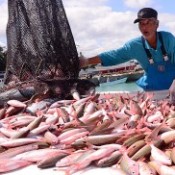
May 23 2012 Ryukyu Shimpo
On May 22 at the Toya fishing port in Yomitan, there was a large catch of banana fish, known locally as gurukun, the prefectural fish of Okinawa. This catch is said to signal the arrival of summer. The total weight of the catch amounted to three tons, the largest ever to date. People involved in the fishing industry said, “It was a real surprise to catch such a huge amount of fish.”
The banana fish, which have a characteristic yellow double-line on their pink colored body, were caught off the Toguchi district of Yomitan in fixed nets set by the Yomitan Fisheries Cooperative Association. According to a representative of the association, this is the largest number of these fish ever caught at one time since 1992 when the association first set up the nets. The catch usually amounts to just several dozen kilograms and the previous largest amount was 300 kilograms recorded on May 11 this year.
According to the association representative, the daily catch amounts to around 100 kilograms for the entire the prefecture. Akira Maeda of the association, said, “It is definitely the largest catch of banana fish in the history of Yomitan. Even though we thought that we had already caught lots of these fish this year, this catch really surprised me. We would like people to eat the banana fish raw and sliced while it is still fresh, but it also tastes good grilled.”
Large banana fish measuring 25 centimeters in length and weighing 250 grams were landed on this occasion. Auctions were actively conducted at the port and the fish were dispatched to supermarkets all over the prefecture. Iyu, a direct sales store in the port, started selling the fish at a very reasonable price.
(English translation by T&CT, Mark Ealey)
Go to Japanese
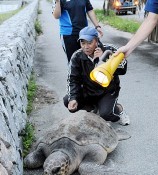
May 22, 2012 Ryukyu Shimpo
After 5:00am on May 21, on the road at Hentona in Kunigami, a driver on Route 58 found a loggerhead turtle, which is designated as an endangered species. In the brisk hours of the early morning, passersby and police officers cooperated to get the turtle back to the beach.
May to July is the laying season for loggerhead sea turtles, and it seems that this turtle also came ashore to lay eggs, but she wandered onto the road in the process of searching for a good site.
The length of the turtle was 85.4 centimeters (33.6 inches) and it weighed about 90 kilograms (198.4 pounds). Muneyuki Kayo, a member of the Sea Turtle Association of Japan who happened to be researching the egg-laying of sea turtles at location nearby, and some others, guided the turtle onto the sidewalk. From there, they lifted her up and carried her to the beach where before 6:00am, surrounded by a crowd of more than ten people, she made way back into the sea.
Kayo said, “Looking at the tracks behind her, the turtle had crossed the main road, so it is lucky that she didn’t get hit by a car. The person who discovered her saved her by reporting her to the police and passersby stopped to watch her being rescued. I hope that many people understand that these turtles come quite close to the main road to lay their eggs.”

At 5:45am on May 21, the loggerhead turtle safely returned to the sea.
(English translation by T&CT, Lima Tokumori and Mark Ealey)
Go to Japanese

Go To Video
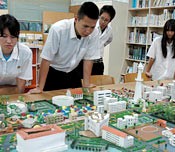
May 22, 2012 Ryukyu Shimpo
A large-scale model made in 1995 by students of Futenma High School to reflect what the redevelopment of land currently used by the U.S. Marine Corps Air Station Futenma might look like, has been on displayed in the library of Motobu High School since May 10.
The students of Motobu High School partially restored the model. The school’s principal, Yoshinori Higa, who came up with idea of the model during his time teaching at Futenma High School, had been storing it. Higa said, “I would like students in the northern area of Okinawa to take this opportunity to think about the current state of affairs in Okinawa.”
The model is 1.5 meters wide, and three meters long. Higa came up with idea of creating the model as an exhibition for the school festival, and the students worked on the project.
The model represents the dreams of students of Futenma High School for the redevelopment of land currently used by Futenma Air Station. It includes a monorail, an outdoor amphitheater and a residential area.
Higa reflects on that time, saying, “High school students in the central area of Okinawa were used to the existence of the base because it had been there from before they were born, but when they learned about Okinawa they became aware of the dangers involved with a base being located in such a densely populated area.”
Rena Harakuni, a student of Motobu High School who helped restore the model for display, said, “I was not particularly interested in the issue of Futenma and Henoko. But after I watched a TV program about the 40th anniversary of Okinawa’s reversion to Japanese sovereignty, I thought that I must come to terms with the fact that U.S. military bases are still in Okinawa.” With regard to the dreams represented by the model created by students of Futenma High School 17 years ago, Harakuni said, “It would be great if these dreams come true.”
The Sakima Art Museum temporarily exhibited the model but Higa later repossessed it. He has been displaying it at the schools to which he has been transferred. The model will be displayed until June 23, the anniversary of the end of the Battle of Okinawa.
(English translation by T&CT, Mark Ealey)
Go to Japanese
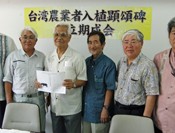
May 19, 2012 Ryukyu Shimpo
It has been decided that a monument to the Taiwanese farmers who emigrated to Ishigaki island in the prewar period and introduced agricultural know-how by bringing a water buffalo and pineapples to the island, will be set up in the car park of Nagura Dam in Ishigaki. Tsuyoshi Iha, the president of the group in charge of erecting the monument, announced this on May 11 at the Ishigaki Municipal Office. With regard to the introduction of pineapples to the island, there was friction between the local people and the Taiwanese immigrants so the descendants of the settlers welcome the building of the monument. The unveiling of the monument will be on Pineapple Day on August 1.
A total of 330 Taiwanese farmers from about 60 households emigrated to the Nagura district of Ishigaki in 1935 bringing pineapple seedlings. After that, they brought 30 water buffalos to the island. In 1938, canned pineapple was produced for the first time in Okinawa, and then exported to the main islands of Japan.
Although the Minister of the Army prohibited the manufacture of canned pineapple as an extravagance during the war, Taiwanese immigrants secretly stored pineapple seedlings, which helped with the revival of the pineapple industry after the war. The Ryukyuan Government promoted pineapple production along with sugarcane production as key industries for Okinawa. Pineapples were produced not just in the Yaeyama region, but all over the prefecture.
To begin with, the people of Yaeyama plowed their land manually, so the use of water buffaloes was a breakthrough for them. There as friction between the Taiwanese immigrants and the locals, who felt threatened that their land being usurped and this led to incidents of violence and injury.
Iha said, “Okinawa has benefited from the pineapple industry. It has widely influenced not just the primary industries but also land transportation, seaborne shipping and the work environment in Okinawa. The Taiwanese immigrants did a great deal building the foundation of the pineapple industry.”
Takeshi Miki, the vice-president of the group said, “We should not forget how pineapples were brought into Okinawa. We need to understand the twists and turns of history. It is good that the people of Yaeyama are to erect a monument in appreciation of the efforts of the Taiwanese immigrants.”
Kanei Goya, the head of the Yaeyama branch of the Ryukyu Overseas Chinese Assembly, said, “For quite some time local people in Ishigaki have talked of setting up something to honor the Taiwanese immigrants. I am very pleased that this monument will be erected.”
(English translation by T&CT, Mark Ealey)
Go to Japanese
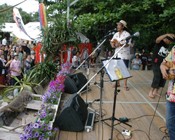
May 12, 2012 Ryukyu Shimpo
On May 3, the 15th Hatoma Island Music Festival was held in the plaza in front of the community center on Hatoma Island. About 1000 people from all over Japan visited the island that normally has a population of just 63 people.
In addition to famous musicians, Masaru Shimabukuro of BEGIN, Kiyosaku of Mongol800, pupils of the Hatoma Elementary and Junior High School, people of the Hatoma Folk Entertainment Preservation Society, and local residents performed. They danced together to a variety of music such as folk songs, pop, samba and school songs and thoroughly enjoyed the music.
Around the venue, local specialties of duck soba and goat dumplings were sold. In order to provide support for Ishinomaki in Miyagi, an area affected by the Great East Japan Earthquake, people sold hama no misanga or good-luck bracelets made by fishermen.
At the end of the festival, all the performers and the people in the audience danced to the song Hatoma no minato and enjoyed this large event on the tiny island.
Taku and Miwa Futenma, a couple visiting the festival for their honeymoon, said, “It was fun to listen to so much good music. We are still in the mood for dancing!”
(English translation by T&CT, Lima Tokumori and Mark Ealey)
Go to Japanese

















 Webcam(Kokusai Street)
Webcam(Kokusai Street)


